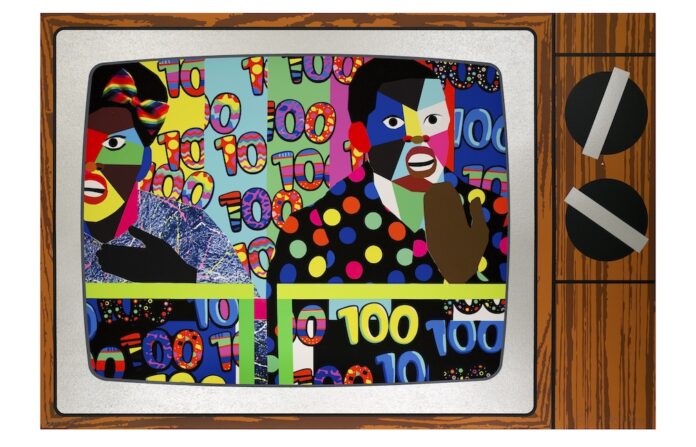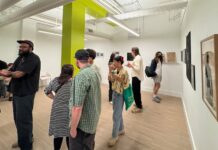
This article appears in the January/February 20234 print issue of Boston Spirit magazine. Subscribe for free today.
The Portland Museum of Art’s exhibition “+ collection,” on view February 2 to April 28, celebrates some of the Maine museum’s most recent acquisitions. The show is also an intentional examination of how collections are made: which artists are represented, whose stories are told and who or what has been historically excluded.
“The show is historical and contemporary. Certainly the way in which we look at artists now, we think about LGBTQ identity or BIPOC identity as being a really central part of how they might think about their work,” says the show’s curator, Shalini Le Gall, PMA’s chief curator and Susan Donnell and Harry W. Konkel Curator of European Art. But historically that was rarely the case. One of the interesting aspects of the show is realizing the number of artists who could not be open about important parts of their ethnic, sexual or gender identities.
Since most art enters collections as gifts to museums, Le Gall says, what does it mean for outsider artists who may not get to show or, perhaps more importantly, to sell art?
“If you don’t get your work into a collection that can then be gifted, what does that mean for how a story is told? We wanted to unpack that in this exhibition and talk about how part of the work of a museum is also recovering the stories that may not be in other collections and that may not come in through gifts. We have to take some agency and go out and find the material and recover those stories. That’s how you grow a collection to tell a broader, more expansive story,” she says.
To that end, + collection highlights the transparent and evolving nature of the PMA’s Art for All mission and how it impacts its galleries, exhibitions and the museum’s artistic program as a whole. Over the last decade, it has taken deliberate steps to expand the narratives it can tell through its artwork.
There are 70 works in the + collection exhibit, curated from works gifted to PMA over the past several years. It’s a small sampling from the more than 19,000 objects in the PMA collection. But the 70 works tell a story of past and present, and how established and outsider artists are often in conversation with one another.
This is evidenced by the women artists who “negotiated and navigated working outside the framework,” says Le Gall, who cites Paulina Peavy, an artist connected with Cal Arts, Hans Hoffman and the Los Angeles Art Students League but that even La Gall was unfamiliar with until now. “Her life span was the entire twentieth century. She’s a fascinating figure who showed in same places as modernist artists like Diego Rivera on the West coast but was identified as eccentric because she participated in seances; because she insisted on living her life as an independent woman. For a large chunk of history, that was grounds enough to have you dismissed as an eccentric woman artist,” says Le Gall.
Peavy, who died in 1999, is represented by “Untitled” from 1978, part of her Smokies Series of smoke-on-clay–coated paper. Peavy developed a practice that aligned modernism with spiritualism, cosmology and the occult. This “smokie,” as Peavy called such works, was made by maneuvering a thin piece of gloss paper, coated in glaze, over a smoke source.
The exhibition juxtaposes artists from different time periods and those working with different methods. Contemporary artist Kathy Butterly’s “Pinkscape” (2018) is composed of nail polish that has been poured onto a physical page from a past exhibition catalogue of Butterly’s work. “The process (and result) makes it difficult for viewers to distinguish applied materials from the original surface and highlights the unique chemical aspects of nail polish,” Le Gall writes in the accompanying text. “Butterly writes, ‘Nail polish acts very much like glaze . . . there are nuances in the pigments and each bottle acts differently.’ For the artist, working with nail polish is a feminist act that points to the expensive materials required to maintain specific beauty standards.”
Also represented in + collection is acclaimed contemporary artist Kiki Smith, known for work that addresses the themes of sex, birth and regeneration. Smith’s collaborators included gay AIDS activist David Wojnarowicz, and her figurative work in the1980s and early ’90s confronted subjects such as AIDS, feminism and gender.
There are also pieces by Mary Ann Unger (1945–’98) who rose to prominence in the downtown New York art scene in the 1980s and ’90s; multidisciplinary artist Derrick Adams whose vibrant work celebrates contemporary Black life and culture; renowned British sculptor Tony Cragg; photographer Gordon Parks (1912–2006) whose work famously chronicled American civil right and social justice movements; Maine artist Elizabeth Atterbury; and modern German artist Pia Fries, whose large-scale oil and silkscreen painting “lochtrop” (2005) is an anchor piece in the show.
Highlighting these artists and putting them in conversation with one another “does not happen passively,” says Le Gall. “You have to be committed to finding the work out there and looking for the story.” [x]
More: portlandmuseum.org









